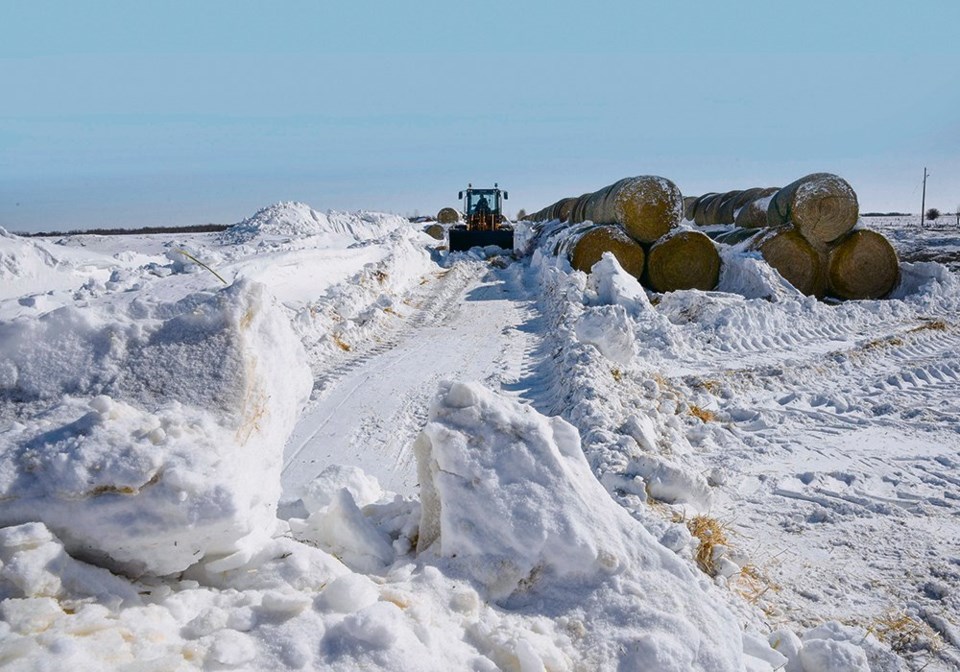WESTERN PRODUCER — Snow sitting on previously parched prairie soil may be just the thing to recharge moisture levels. But it depends.
Melt conditions will determine how much moisture from that snow actually soaks in.
As of early March, accumulated precipitation over the winter in Alberta and Saskatchewan varies but is in the normal to above normal range. There are stubborn pockets of dry conditions plaguing areas in southeastern Alberta and southwestern Saskatchewan.
Sean Osmar from Saskatchewan’s Water Security Agency says run-off data released earlier this month only provides a snapshot of conditions leading into spring but more snowfall in the next few weeks will improve moisture levels.
“Because we went into freeze -up with such a (moisture) deficit, we needed more (snow), we needed well above normal to get back to where we should be,” said Osmar, noting only a band stretching across the central portion of the province is in that desired range.
Osmar said the areas that make up the Palliser Triangle in the southwestern corner of the province are historically dry with variable weather conditions in the spring — a trend that continued this winter and may cause reduced reservoir levels. But a lot can change in the next few weeks.
Overall, reservoir levels across Saskatchewan are predicted to be good.
“The foothills in Alberta didn’t get as much snow, so that will factor in how much flows into the province,” said Osmar.
“We are expecting major reservoirs and inflows into Lake Diefenbaker to be around normal. We’re expecting to still meet all the demands for the province from the major reservoirs.”
There is room for improvement in moisture conditions as seeding time approaches.
“We still have some time left for additional snow, as much as we may be tired of shovelling it, but there are still a few weeks left in the snow season. We could still see some more and that will certainly help,” said Osmar.
There are promising signs, he added, with the alpine snowpack feeding into the South Saskatchewan River basin looking solid with above-normal accumulations which, combined with spring rains, could improve moisture conditions.
Current long-term forecasts are optimistic, said Osmar, who also cautioned against putting too much faith in such predictive modeling.
“Some of those forecasts indicate we could be in for a slower melt, a cooler spring with still some precipitation to come. That will certainly help,” he said. “Southern Alberta and Saskatchewan, the weather does change, it’s quite variable so we want to see how that comes through and plays out.”
Osmar said the next runoff report in April should be able to paint a clearer picture of spring and summer moisture conditions.
Phillip Harder, research associate at the University of Saskatchewan’s Centre for Hydrology, said the snowpack melt will be a big factor in determining how the landscape will be able to take advantage of the winter moisture.
“How much moisture could get into the soil, your potential, is often going to be different than your actual based on a number of factors,” said Harder, adding there will be at least some soil moisture level recovery this year.
The benefits of a large snowpack can be lost if the melt happens too quickly, which leads to excessive runoff instead of allowing the moisture to soak into soils, he said.
“In Manitoba where we have tonnes of snow, their infiltration will be maximized and they are going to get the most recovery,” said Harder.
But in Saskatchewan and Alberta, some of the mid-season melts have caused layers of ice to form above the soil that may inhibit moisture absorption. These areas with ice lenses caused by the freeze-thaw cycle will prevent regions with moderate snow cover from realizing their full soil moisture recovery.
“That’s really going to limit how much gets in,” said Harder. “If we hadn’t had those melts, I suspect most of everything would be going in.”
Harder called the phenomenon the wildcard in predicting moisture saturation levels from snowfall this year.
As well, areas that saw late fall rain followed by freezing conditions may have areas where moisture is less likely to seep into soils, said Harder.
“You can be dry underneath but if you have a layer of saturated soil on the surface, that’s going to be that layer that prevents anything from getting through.”
Producers can take some steps in determining whether their pasture or fields are being impacted by ice lenses. It comes down to knowing how much snow you have, what the surface soil conditions are and what your water content was in the fall, he said.
In Saskatchewan, Harder said he is seeing water density at an average of 30 percent of snowpack that will translate to about three inches of maximum water absorption for every 10 inches of snow.
If there’s a frozen layer above the soil, “that’s going to limit how much gets in, to the point it’s almost a negligible amount,” said Harder.
If the soil is loose and dry below the snow, “most everything is going to get in.”
And if the soil comes up in clumps when digging into it, that’s frozen soil that will moderate moisture uptake depending on what levels were like in the fall.
“If it’s a pretty wet soil in fall, you’re not going to get a lot in versus (if) it’s 50 percent of your total water storage, you’re possibly going to get a couple of inches in but not all of your snow,” said Harder.
As for the alpine snowpack, Harder, who is conducting research on the topic in Kananaskis, Alta., said “there will be water in the rivers this year,” as there is lots of snow in the mountains.

